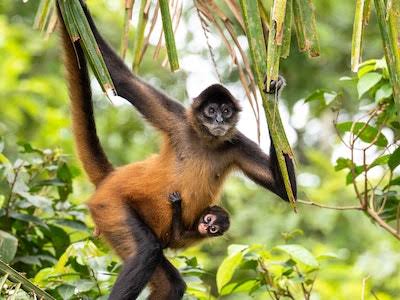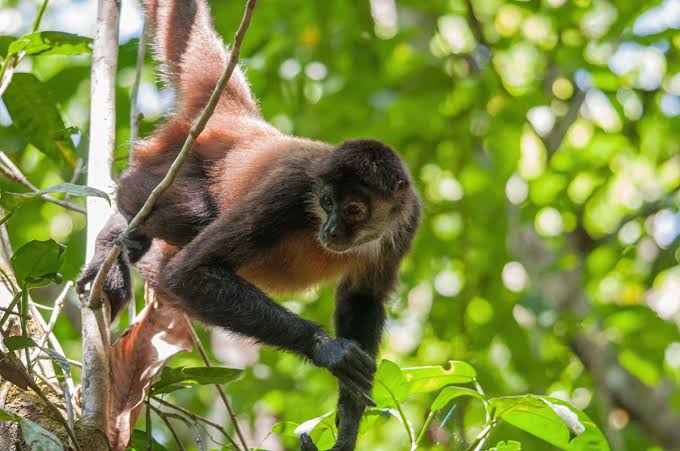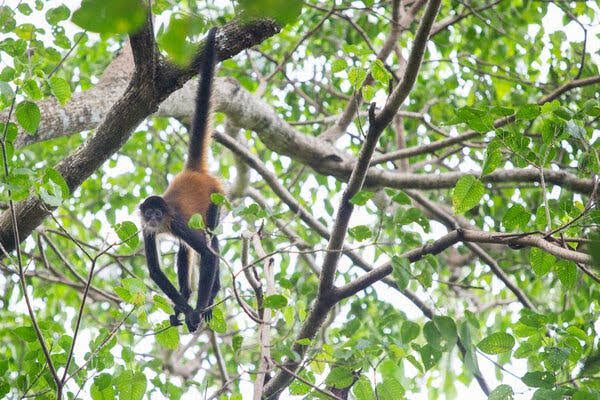Monkeys are fascinating creatures that live in various parts of the world. These animals are members of the primate family, just like humans. Monkeys come in different shapes, sizes, and colors, making them a diverse group.
In the wild, monkeys can be found swinging from trees, exploring the forest, and playing with each other. They are known for their agility and cleverness. Monkeys have long arms and tails, which help them balance and move easily in their natural habitat.
One interesting thing about monkeys is their social nature. They often live in groups called troops, and within these groups, they form close bonds. Monkeys communicate with each other through sounds, gestures, and facial expressions. This helps them cooperate and stay connected in their daily activities.
There are two main types of monkeys; Old World monkeys and New World monkeys. Old World monkeys are found in Africa and Asia, while New World monkeys inhabit the Americas. Each type has its own unique characteristics and behaviors.
Monkeys are omnivores, which means they eat a variety of foods. Their diet includes fruits, leaves, insects, and sometimes even small animals. This adaptability in their diet allows them to survive in different environments.
These playful creatures are also known for their intelligence. Monkeys have been observed using tools, solving problems, and even learning from each other. Some species of monkeys have a remarkable ability to adapt to changing conditions, showcasing their cognitive abilities.
Humans share a common ancestor with monkeys, which is why we have some similarities in our DNA. However, it’s essential to remember that while monkeys and humans have similarities, they also have distinct differences.
Conservation efforts are crucial to ensure the well-being of monkey populations. Deforestation, habitat loss, and illegal wildlife trade pose significant threats to these animals. Many organizations and researchers work tirelessly to protect monkeys and their habitats.
In addition, monkeys are captivating creatures with unique qualities. Their social nature, intelligence, and adaptability make them an essential part of the natural world. Understanding and appreciating these remarkable animals is vital for their conservation and the preservation of biodiversity.
Monkeys exhibit a wide range of behaviors that showcase their complex social structures. Within monkey troops, there is often a hierarchy, where dominant individuals have higher status and privileges. This hierarchy is maintained through various interactions, including displays of dominance and submission.
Play is another important aspect of monkey behavior. Young monkeys engage in playful activities, helping them develop crucial skills for survival. Play also strengthens social bonds within the group. Monkeys can be seen chasing each other, wrestling, and engaging in games that mirror real-life situations.
Monkeys’ vocalizations are diverse and serve various purposes. They use different sounds to communicate danger, express excitement, or signal submission. Some species have intricate vocal repertoires, allowing them to convey a wide range of messages to their fellow troop members.
One fascinating feature of monkeys is their grooming behavior. Mutual grooming serves both social and hygiene purposes. Monkeys pick through each other’s fur, removing parasites and establishing social bonds simultaneously. This grooming ritual is not only beneficial for their physical well-being but also strengthens the social fabric of the troop.
As with many animals, monkeys have adapted to their environments over time. Their physical characteristics, such as prehensile tails and grasping hands, help them navigate their surroundings with ease. These adaptations contribute to their survival and success in diverse habitats.
The reproductive behavior of monkeys varies among species. In some cases, there are elaborate courtship rituals, while in others, the dominant male may have exclusive mating rights. Female monkeys typically invest a significant amount of time and effort in raising their offspring, emphasizing the importance of family bonds within the troop.
Monkeys, like other wildlife, face threats from human activities. Deforestation, pollution, and the expansion of urban areas encroach on their habitats. Conservation initiatives aim to address these challenges, focusing on habitat preservation, education, and sustainable practices to ensure the well-being of monkey populations.
In studying monkeys, scientists gain valuable insights into the natural world and the interconnectedness of all living beings. Their behaviors, social structures, and adaptations contribute to our understanding of evolution and the intricate web of life on Earth.
In essence, monkeys are not only charismatic and entertaining creatures but also integral components of ecosystems worldwide. Appreciating and safeguarding these remarkable animals contribute to the broader effort of preserving biodiversity and maintaining the delicate balance of our planet’s natural diversity.
Read Also: Guide On How To Increase Goats Milk
History and Origin of Monkeys

Monkeys have a long history that stretches back millions of years. Their origin is connected to the broader story of life on Earth. Let’s take a journey into the past to understand how monkeys came to be.
Many, many years ago, there were no monkeys as we know them today. Instead, there were small, primitive mammals living in trees. These early tree-dwellers faced challenges, and over time, some developed unique traits that would later define monkeys.
As Earth changed, so did these tree-dwelling mammals. They adapted to their environments, and some developed grasping hands and feet, which helped them move around in the trees. This adaptation was a crucial step in the evolution that led to the monkeys we see today.
The ancestors of monkeys belonged to a group of mammals called primates. These early primates lived around 60 million years ago. Over time, they split into two main groups: the prosimians, which include lemurs and tarsiers, and the anthropoids, which eventually gave rise to monkeys and apes.
Around 35 million years ago, the first monkeys appeared. These early monkeys were smaller than the ones we see today. They continued to evolve, adapting to different environments and developing traits that helped them survive.
Monkeys’ ability to swing from branch to branch in the trees, known as brachiation, became a distinctive feature. This adaptation allowed them to access food and escape from predators. Over time, monkeys diversified into different species, each with its own characteristics and behaviors.
As the Earth’s continents drifted and climates changed, monkeys spread to different parts of the world. In Africa, Asia, and the Americas, various monkey species emerged, adapting to their specific habitats.
One important thing to note is that monkeys are not the same everywhere. There are two main types of monkeys: New World monkeys, found in the Americas, and Old World monkeys, found in Africa and Asia. Each type has its own unique features and behaviors.
The evolution of monkeys is intertwined with the larger story of life on our planet. They adapted and changed over millions of years, becoming the playful and diverse creatures we observe today. Studying the history and origin of monkeys helps us appreciate the incredible journey of life and the interconnectedness of all living beings.
Health and Lifespan of Monkeys
Monkeys, like humans, experience a range of health factors that influence their lifespan. While specific details can vary among different monkey species, some general aspects of their health and longevity can be explored.
1. Social Dynamics: Monkeys are social animals, and their well-being is often tied to the dynamics within their groups. Social interactions, hierarchy, and cooperation play essential roles in their mental and emotional health.
2. Diet and Nutrition: The diet of monkeys varies across species, including fruits, leaves, insects, and sometimes small animals. Access to a balanced and nutritious diet is crucial for their overall health and longevity.
3. Reproductive Health: Reproductive factors significantly impact the health of monkey populations. Female monkeys typically invest considerable time and effort in raising their offspring, and the ability to reproduce successfully contributes to the survival of the species.
4. Environmental Factors: The habitat and environment in which monkeys live have a direct impact on their health. Changes in climate, deforestation, and human activities can pose threats to their well-being and affect their lifespan.
5. Disease and Parasites: Monkeys, like any other species, are susceptible to diseases and parasites. Conservation efforts often include monitoring and managing health risks to prevent the spread of illnesses within monkey populations.
6. Genetics: Genetic factors can influence the health and longevity of monkeys. Some species may have genetic predispositions to certain health conditions, while others may exhibit resilience to environmental challenges.
7. Human Interaction: Human activities, such as habitat destruction, illegal wildlife trade, and encroachment, can pose significant threats to monkey populations. Conservation efforts aim to address these human-related factors to ensure the well-being of monkeys.
8. Predation and Survival Strategies: Predation is a natural challenge for monkeys, and their ability to develop survival strategies, such as vigilance and group cooperation, contributes to their overall lifespan.
9. Aging and Life Stages: Monkeys, like humans, go through different life stages. Understanding the aging process is essential in assessing their health and implementing appropriate conservation measures.
While there is diversity among monkey species, the overall health and lifespan of monkeys are influenced by a combination of biological, environmental, and social factors. Conservation efforts play a vital role in preserving their habitats and addressing human-related threats to ensure the well-being of these intelligent and adaptive creatures.
Read Also: Sheep and Goat Housing Complete Guide
Nutrition and Feeding of Monkeys

Monkeys, being diverse creatures with various species, exhibit a range of feeding modes and nutritional preferences. Let’s see how these fascinating animals obtain their nutrition and the different ways they feed.
1. Omnivorous Appetite: Many monkey species are omnivores, meaning they eat a mix of plant-based and animal-based foods. Their diet can include fruits, leaves, seeds, insects, small mammals, and sometimes eggs. This adaptability allows them to thrive in different environments.
2. Fruitful Endeavors: A significant portion of a monkey’s diet often consists of fruits. They play a crucial role in dispersing seeds, as monkeys eat fruits and then spread the seeds in different locations, contributing to the growth of plants and trees in their habitat.
3. Foliage Feeding: Some monkeys primarily feed on leaves, buds, and young shoots. Their digestive systems have adaptations that help them break down complex plant materials to extract nutrients effectively.
4. Insect Interactions: Insects provide a valuable source of protein for many monkey species. Monkeys may forage for insects in trees, on the ground, or even extract them from bark, showcasing their resourcefulness.
5. Social Eating: Monkeys often engage in social eating, where group members share and consume food together. This communal behavior helps strengthen social bonds within the group.
6. Tool Usage: Certain monkey species have been observed using tools to obtain food. This can include using sticks to extract insects from tree bark or using rocks to crack open nuts, demonstrating their problem-solving abilities.
7. Dietary Adaptations: Monkeys have adapted to their environments, developing specialized diets based on the available food sources. This adaptability allows them to thrive in various ecosystems, from tropical rainforests to arid savannas.
8. Grooming and Social Bonding: Grooming isn’t just about cleanliness; it also serves social purposes. Monkeys engage in mutual grooming, not only removing parasites from each other’s fur but also reinforcing social bonds within the group.
9. Water Sources: Access to water is crucial for monkey species. They obtain hydration from various sources such as rivers, streams, and rainwater collected on leaves. Some species have adapted to arid environments and can derive water from the food they consume.
Understanding the diverse feeding modes and nutritional strategies of monkeys provides insights into their ecological roles and adaptations. These creatures showcase a remarkable ability to thrive in different habitats by utilizing a variety of food resources, contributing to the overall balance of ecosystems.
Economic Benefits of Monkeys
Monkeys, while primarily wildlife and not domesticated for economic purposes, indirectly contribute to various economic aspects. Here are some ways in which monkeys can have economic benefits:
1. Ecotourism: Wildlife, including monkeys, can be significant attractions for ecotourism. Tourists often visit natural habitats to observe and appreciate these creatures. This tourism generates income for local communities, supporting jobs in the hospitality industry and creating economic incentives for habitat conservation.
2. Research and Education: Monkeys are subjects of scientific research, contributing to our understanding of biology, behavior, and evolution. This research can have broader applications, including medical advancements. Educational programs and institutions benefit from the knowledge gained through the study of these animals.
3. Biodiversity Conservation: Conservation efforts aimed at protecting monkey populations also contribute to maintaining biodiversity. Biodiversity is essential for ecosystem health and resilience, which, in turn, supports various industries such as agriculture, fisheries, and pharmaceuticals.
4. Seed Dispersal: Monkeys play a crucial role in seed dispersal by eating fruits and then spreading seeds in different locations. This natural process aids in the regeneration of forests and can have economic benefits for industries relying on sustainable timber and non-timber forest products.
5. Scientific Advancements: The study of monkeys provides insights into genetics, cognition, and behavior. These insights can contribute to scientific advancements, including the development of medical treatments and technologies. The economic impact of such advancements can be far-reaching.
6. Cultural and Aesthetic Value: Wildlife, including monkeys, often holds cultural significance. Preserving these species contributes to the aesthetic and cultural value of natural environments, attracting individuals interested in conservation and supporting related initiatives.
7. Ecosystem Services: Monkeys, as part of ecosystems, provide various services such as pest control, pollination, and nutrient cycling. These ecosystem services benefit agriculture and other industries indirectly by maintaining the health and functionality of natural systems.
While the direct economic benefits of monkeys may not be as tangible as those of domesticated animals or agricultural crops, their ecological roles and the services they provide contribute to the overall health of ecosystems, which, in turn, can have positive economic implications for both local and global communities. Recognizing and preserving the value of biodiversity, including monkeys, is essential for sustainable economic development.
Grooming and Care Guide of Monkeys

While monkeys are primarily wild animals, there are instances where they may be kept in captivity, such as in wildlife rehabilitation centers or sanctuaries. In such cases, providing proper grooming and care is crucial for their well-being. Here is a general guide:
1. Knowledge of Species: Understand the specific needs and behaviors of the monkey species in your care. Different species have varying dietary requirements, social structures, and habitat preferences.
2. Diet and Nutrition: Provide a balanced and species-appropriate diet. This may include fruits, vegetables, nuts, and protein sources. Consult with experts or veterinarians to create a nutrition plan tailored to the specific monkey species.
3. Enclosure and Enrichment: Create a secure and spacious enclosure that mimics the monkey’s natural habitat. Include structures for climbing, hiding spots, and objects for mental stimulation. Enrichment activities, such as puzzle feeders or toys, are essential for keeping them mentally active.
4. Social Interaction: Monkeys are social animals, and being alone can lead to stress and behavioral issues. Whenever possible, house them with compatible individuals of the same species to promote social interactions. Ensure there is enough space for each monkey to establish its territory.
5. Veterinary Care: Regular veterinary check-ups are crucial. Find a veterinarian experienced in treating primates. Vaccinations, parasite control, and dental care are essential components of their health maintenance.
6. Grooming and Hygiene: Monkeys engage in mutual grooming as a social bonding activity. While they often groom themselves, observe for any signs of skin issues, parasites, or injuries. If necessary, provide a shallow dish of water for them to engage in natural grooming behavior.
7. Temperature and Climate: Ensure the enclosure is suitable for the species’ natural habitat. Provide shade and shelter from extreme temperatures. Monkeys are sensitive to temperature changes, so monitoring their environment is crucial.
8. Behavioral Observation: Pay attention to changes in behavior. Aggression, lethargy, or changes in appetite may indicate health issues or stress. Understanding their natural behaviors helps identify abnormal patterns.
9. Training and Positive Reinforcement: Use positive reinforcement techniques for training. This can facilitate veterinary examinations and other necessary care activities. Positive interactions build trust between caregivers and monkeys.
10. Legal Considerations: Before keeping a monkey, be aware of and comply with local and international laws and regulations. Some species are protected, and ownership may require permits or be prohibited.
It’s important to note that keeping monkeys as pets is discouraged due to the complex care they require and the potential negative impact on their well-being. In many places, keeping certain species of monkeys may also be illegal. If you encounter a monkey in need, consider contacting wildlife authorities or rehabilitation centers for appropriate care and release strategies.
Read Also: Texas Business and Finance
